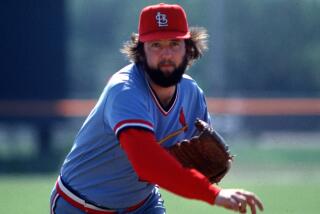ON CALL FOR COOPERSTOWN
- Share via
When the baseball writers peek into the sealed envelope Tuesday and reveal their choices for the Hall of Fame, it would be nice if they anointed a couple of members of baseball’s least appreciated fraternity--relief pitchers.
Here’s a vote for Goose and another for Bruce.
Those who pass on them should have to face some vintage Goose Gossage gas and flail after one of Bruce Sutter’s split-finger fastballs.
In their prime, these two bordered on unhittable.
Gossage had the kind of intimidating heat that would push the speed gun to its limits. Sutter was the master of the split-finger pitch that looked like an innocent fastball on its way to the plate and then darted into the dirt at the last instant, leaving hitters looking foolish.
Together, they put up some fancy numbers.
Sutter saved 300 games and won 68 others in 12 seasons, with a 2.95 earned run average. He won the Cy Young Award in 1979 when he led the league with 37 saves, and was the MVP of the 1982 World Series.
Gossage had 310 saves, won 124 games, and his 3.01 ERA came compliments of a fastball to fear. He was the Sporting News Fireman of the Year twice and set a National League record for most strikeouts by a relief pitcher in 1977 when he cut down 151 batters in 133 innings.
These were a couple of classic relief pitchers, equipped with the right stuff to close the case. They shortened ballgames. If their teams got Sutter and Gossage to the mound in the late innings, the issue was just about over. They dominated, and domination is what the Hall of Fame is all about.
Until now, the bullpen craft has largely been overlooked by Hall of Fame voters. Somehow just two relievers--Hoyt Wilhelm and Rollie Fingers--have made it to Cooperstown. Now, Sutter and Gossage deserve to join them.
Perhaps they suffer by the image of early relief pitchers, who, for a long time, were nothing more than broken-down starters, relegated to the bullpen for mopup duty. In those days, there were no such things as saves. That statistic was kept only informally and didn’t become an official rule until 1969.
It was then that baseball began to appreciate just how important a role bullpens play for pennant contenders. Just ask Joe Torre what life at Yankee Stadium would be like without Mariano Rivera. The game has evolved and closers have become an intricate part of the equation.
These days, bullpens are arsenals of arms with specialists for every conceivable situation, long men to bridge the middle innings, short men to pitch no more than one inning, perhaps to no more than one batter.
It was a task that Gossage and Sutter mastered.
Relief pitching requires a thick skin and a short memory, the ability to shrug off a bad outing and come back the next day, convinced that the poor stiff in the batter’s box doesn’t have a chance, no matter what happened yesterday.
Relievers strut--sometimes run to the mound -- eager to bail out a pitching partner from a mess. There is a message there, an arrogance that borders on belligerence, a mindset necessary for the task.
In the opening game of the 1954 World Series between the Cleveland Indians and New York Giants, Sal Maglie got in an eighth-inning jam and had two men on base. With lefty-swinging Vic Wertz coming up, manager Leo Durocher played the percentages and went to his bullpen for left-hander Don Liddle.
Wertz hit a ball about 9 miles to straightaway center field that Willie Mays ran down for one of the most famous catches in World Series history. It was a dazzling play.
Now, with a right-handed hitter coming up, Durocher went to the bullpen again, this time for righty Marv Grissom. As Grissom, the classic used-up starter, trudged toward the mound, Liddle waited for him, looking for all the world rather pleased with himself.
When Grissom arrived, Liddle handed him the ball and, with the kind of aplomb that is the first prerequisite for every successful relief pitcher, casually said, “I got my man.”
More to Read
Go beyond the scoreboard
Get the latest on L.A.'s teams in the daily Sports Report newsletter.
You may occasionally receive promotional content from the Los Angeles Times.










